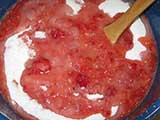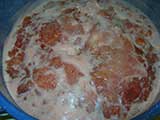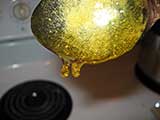Meats and Sausages
Cooking Jams and Jellies
Jams and jellies are cooked to proper density which is verified by the thermometer or spoon-sheet test. A rule of thumb dictates that no more than 8 cups of juice or fruit should be processed at one time. This requires a large deep pan or skillet so that the juice will not boil over and evaporation will be fast.
The mixture of fruit, sugar and water (if any) is brought to a boil, then it is boiled rapidly until a jellying point is obtained. During this procedure the mixture has to be stirred frequently. The amount of sugar in finished jams and jellies is usually around 65%.
Place juice in a large pot, apply slow heat and add 3/4 cup sugar to 1 cup of juice. Stir until sugar dissolves, then apply more heat and boil rapidly (don't simmer), stirring often, to jellying point. Test for completion.
During cooking some foaming can be expected, which is normal. The foam itself is edible. Foaming can be decreased by adding a little butter or margarine (1/4 teaspoon). Foaming was more of a concern in the past, when jellies were sealed with paraffin or wax as the foam was able to trap some air inside. That could create conditions for mold to grow.
Determining the cooking endpoint
To obtain a high quality product the cooking end point temperature should be controlled. Products made at home very often are overcooked. A correct amount of pectin, acid, sugar and juice will produce a strong gel and the right texture of the finished product. This will be also influenced by the cooking endpoint. Slow boiling weakens pectin, darkens the color and imparts the flavor of caramelized sugar. Traditionally made products were often overcooked as the doneness of the product was usually checked by the spoon test alone.
There are four methods that may be used to test jelly made without added pectin for doneness:
Until enough experience is gained, it is difficult to know when the jelly is done. After using the thermometer and spoon-sheet tests a few times, enough confidence can be built to rely on the spoon-sheet test alone.
One of the reason that people make products that do not jell is because they want to use less sugar than the recipe calls for. You have to accept the fact that jams and jellies need plenty of sugar, otherwise they will not gel. The only remedy is to use commercially prepared pectin for making low sugar or no sugar products.





















